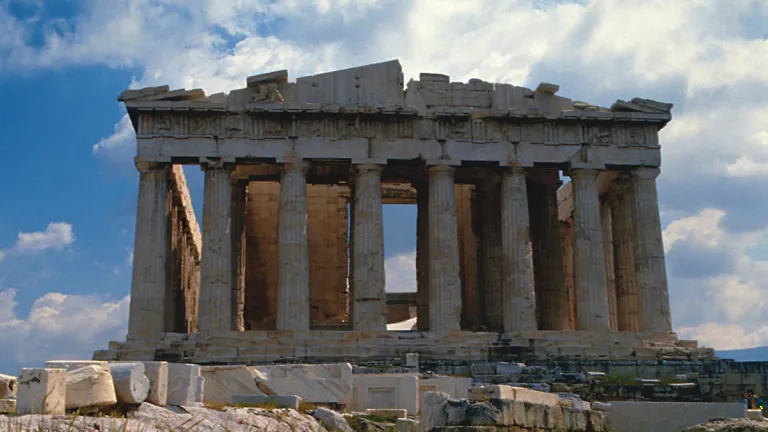The Dreaming King and the Slave

Daniel's book prophesied events fulfilled many centuries ago as well as major events yet to come. It reveals a history of the region, written in advance, from Daniel's time right up to the return of Jesus Christ.
Among the Jewish captives taken from Judah and exiled to Babylon was a young man whose Hebrew name was Daniel. He was renamed Belteshazzar by the Babylonians (Daniel 1:1-7). Daniel lived in the remarkable times of the downfall of the kingdoms of both Judah and Babylon. He served as a slave who became a high official in both the Babylonian government as well as its successor, the Medo-Persian Empire.
At the end of Daniel's book, God instructed him to "shut up the words, and seal the book until the time of the end; many shall run to and fro, and knowledge shall increase" (Daniel 12:4). This indicates that certain major prophecies that previously wouldn't have made sense will be understandable as the end approaches.
Daniel's Prophecies of the Coming Superpower
One amazing prophecy recorded by Daniel is his interpretation of Nebuchadnezzar's dream in chapter 2. In the second year of his reign the Babylonian king had a troubling dream that none of his counselors could explain. Babylonian culture placed considerable emphasis on dreams, and Nebuchadnezzar was convinced that this one was of great importance (Daniel 2:1-3). It turns out he was right: It was a vision of the future, and it was given to Nebuchadnezzar from God Himself.
His dream gives an overview of God's plan beginning then and going through until the return of Jesus Christ. It lists and describes a succession of world superpowers that would dominate the lands surrounding Israel until Jesus establishes His Kingdom (Expositor's, pp. 39, 46). Looking at things in our time, much of the vision has already been fulfilled, which proves its validity for predicting what's still left to happen before Jesus comes back.
By inspiration from God, Daniel explained the details of the dream to Nebuchadnezzar without having heard what the dream was about: "You, O king, were watching; and behold, a great image [a large statue]! This great image, whose splendor was excellent, stood before you; and its form was awesome. This image's head was of fine gold, its chest and arms of silver, its belly and thighs of bronze, its legs of iron, its feet partly of iron and partly of clay" (Daniel 2:31-33).
Daniel told Nebuchadnezzar that his Babylonian Empire was represented by the head of gold (Daniel 2:37-38). The silver, bronze and iron components of the image, or statue, represented three powerful empires that were to follow mighty Babylon (Daniel 2:9-40).
Nebuchadnezzar's dream occurred and was interpreted by Daniel about 600 B.C. The image represented, in symbolic form, the sequence of great empires that would dominate the region's political scene for centuries.
"The silver empire was to be Medo-Persia, which began with Cyrus the Great, who conquered Babylon in 539...This silver empire was supreme in the Near and Middle East for about two centuries" (Expositor's, p. 47).
"The bronze empire was the Greco-Macedonian Empire established by Alexander the Great...The bronze kingdom lasted for about 260 or 300 years before it was supplanted by the fourth kingdom" (ibid.).
"Iron connotes toughness and ruthlessness and describes the Roman Empire that reached its widest extent under the reign of Trajan" (ibid.). Trajan reigned as emperor from A.D. 98-117, and the Roman Empire itself ruled for many centuries.
Daniel 2:44 reveals that the Roman Empire will be in power at the time God will set up His Kingdom: "And in the days of these kings the God of heaven will set up a kingdom which shall never be destroyed; and the kingdom shall not be left to other people; it shall break in pieces and consume all these kingdoms, and it shall stand forever."
The Roman Empire is not in power today, so how is it possible that it will be at the time of Christ's return? After it fell in A.D. 476, there have been several phases or resurrections of the Roman Empire down through history, and the final phase will be the one in power when Jesus comes back. More on that later.
The iron legs were described as having feet and toes composed partly of iron and partly of clay, as Daniel 2:41 explains. Because it is a mixture of strong (iron) and weak (clay) we can surmise that the final phase of the Roman system will be partly strong and partly weak. But why 10 toes? What do they represent? They represent 10 kings—some of them strong, some of them weak—who make up the final phase of the Roman system. Another prophecy revealed to Daniel as well as a section from Revelation help explain this.
Another Dream Adds Important Details
Additional aspects of this succession of world-ruling empires were revealed to Daniel in a later dream. This time the four empires were represented by four beasts: a lion (Babylonian Empire), a bear (Medo-Persian Empire), a leopard (Greco-Macedonian Empire) and a fourth beast described as "terrible" and unlike the other three (Daniel 7:1-7).
"After this I saw in the night visions, and behold, a fourth beast, dreadful and terrible, exceedingly strong. It had huge iron teeth [paralleling the iron legs of Daniel 2]; it was devouring, breaking in pieces, and trampling the residue with its feet. It was different from all the beasts that were before it, and it had ten horns." This beast represents Rome's great power, which crushed all who opposed it.
Notice that it has 10 horns. In biblical literature, a horn can represent a king or leader. The 10 horns of Revelation 13 coincide with the 10 horns of this prophecy, and they represent revivals of the Roman Empire throughout time, leading up to the return of Jesus Christ.
Revelation 17 also helps us in understanding this end-time superpower. In this chapter it's again depicted as a beast. In this description it outright states that it's made up of 10 "kings"—which in modern times could mean presidents, prime ministers or premiers. These leaders collectively "receive authority for one hour" with the ruler of this end-time superpower, an individual the Bible refers to as "the beast" (Revelation 17:12-13). This final revival of the Roman Empire makes war with Jesus Christ upon His return (Revelation 17:14).
All of this concurs with Daniel 2:44, which obviously indicates that the second coming of Christ will occur in a time during which remnants of the fourth beast or kingdom (the Roman Empire) still exist: "And in the days of these kings the God of heaven will set up a kingdom which shall never be destroyed; and the kingdom shall not be left to other people; it shall break in pieces and consume all these kingdoms, and it shall stand forever" (Daniel 2:44).
The greater part of these prophetic events, as detailed by the two dreams, has already been fulfilled. Their detailed completion affirms the divine inspiration of the Bible. The odds of any person foreseeing this on his own defy credibility. "There is a God in heaven who reveals secrets, and He has made known to King Nebuchadnezzar what will be in the latter days" (Daniel 2:28).




